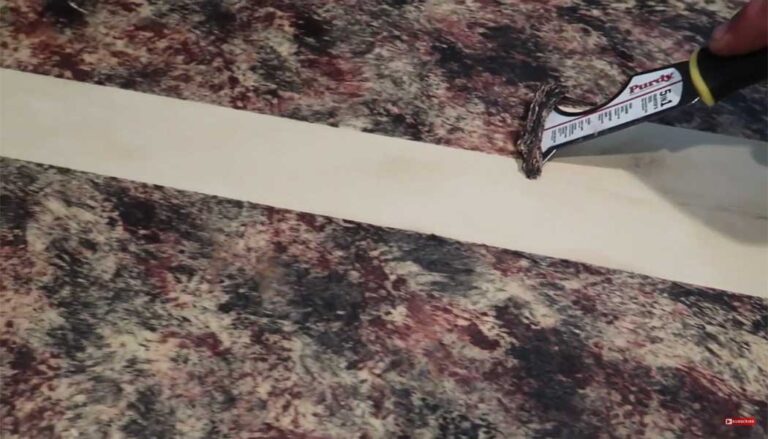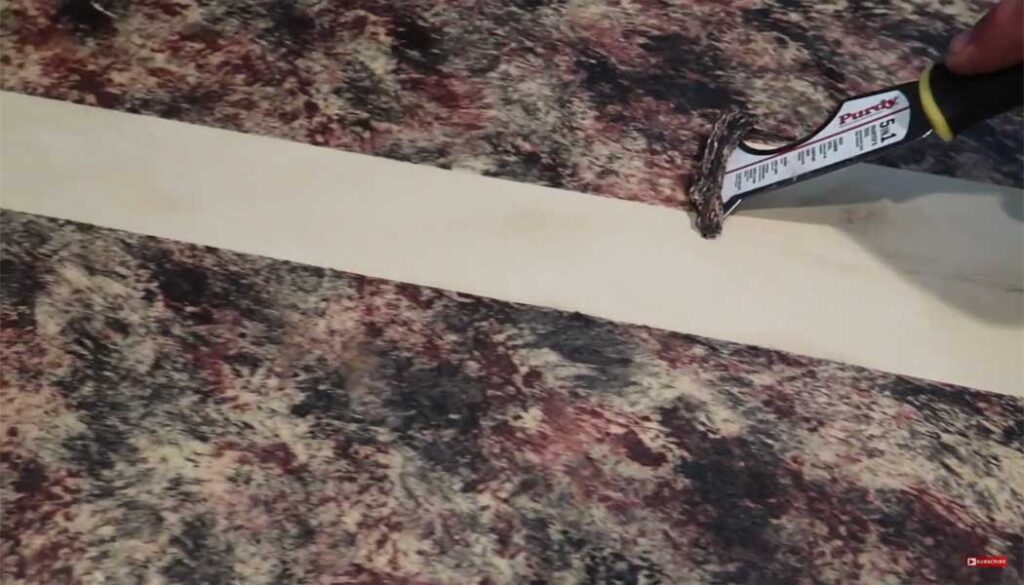
How to Remove Paint from Laminate Countertop?
Removing paint from a laminate countertop can seem like a daunting task. But with the right approach, it can be effectively accomplished without causing damage to the surface.

Whether it’s accidental spills or a creative mishap, you can follow step-by-step instructions and recommended techniques to safely and efficiently remove paint from your laminate countertop. Moreover, you can restore the pristine appearance of your countertop and ensure its longevity.
Does Paint Stick to Laminate Countertops?
Paint generally does not adhere well to laminate countertops. Laminate surfaces are designed to be smooth and non-porous. These surfaces make it difficult for paint to bond effectively. The glossy finish of laminate countertops repels paint and forms a weak bond that is prone to chipping, peeling, or scratching.
In some cases, if the laminate surface has not been properly prepared or cleaned before painting, the paint might appear to stick initially. But over time, it is likely to degrade and become unsightly.
Moreover, the flexible nature of laminate can lead to further challenges. It can expand and contract with temperature changes and cause the paint to crack and flake.
For those seeking to update the look of their laminate countertops, it is advisable to explore alternative methods. For example, they can try using adhesive films specifically designed for countertops or seek professional refinishing services.
If paint has accidentally spilled or splattered onto a laminate countertop, prompt removal is recommended to prevent any potential adhesion and aesthetic issues.
However, while paint might adhere temporarily to laminate countertops, its long-term durability is compromised due to the surface’s properties. It’s better to explore alternative solutions that are better suited to laminate materials to ensure a lasting and attractive result.
How to Remove Paint from Laminate Countertop?
Removing paint from a laminate countertop requires careful attention to prevent damaging the surface. Let’s see a step-by-step guide to safely and effectively remove paint.
Step-1: Act Quickly
The sooner you address the paint spill, the easier it will be to remove. Fresh paint is easier to lift than dried or cured paint.
Step-2: Gather Supplies
You’ll need a few items, including a plastic scraper, clean white cloths, warm water, mild dish soap, rubbing alcohol, and a non-abrasive cleaning solution.
Step-3: Test in an Inconspicuous Area
Before proceeding, test your chosen method on a small, hidden area of the countertop. Ensure it doesn’t cause damage or discoloration.
Step-4: Scrape Excess Paint
Gently use a plastic scraper to lift away any excess paint. Be careful not to scratch the laminate surface.
Step-5: Warm Soapy Water
Mix warm water with a few drops of mild dish soap. Dampen a clean white cloth in the soapy water and gently blot the paint stain. Avoid rubbing, as this could spread the paint.
Step-6: Rubbing Alcohol
Moisten a different white cloth with rubbing alcohol. Blot the paint stain, gently rubbing it in a circular motion. This can help break down and lift the paint. Rinse the area with clean water afterward.
Step-7: Non-Abrasive Cleaner
If the paint persists, use a non-abrasive cleaning solution designed for laminate surfaces. Apply a small amount to a cloth and gently rub the stained area.
Step-8: Rinse and Dry
After using any cleaning solutions, rinse the countertop thoroughly with clean water. Wipe the area dry with a clean cloth.
Step-9: Repeat if Necessary
Stubborn paint stains may require multiple attempts. Always be patient and gentle to avoid damaging the countertop.
Step-10: Finishing Touches
Once the paint is removed, clean the entire countertop with a mild cleaner to ensure a consistent appearance. Polish the surface if necessary to restore its shine.
Step-11: Preventive Measures
To avoid future paint spills, consider using protective coverings or painter’s tape when working on projects near the countertop.
Remember, each laminate countertop can have different properties, so it’s essential to use caution and test any cleaning method in an inconspicuous area first. If the paint stain persists or if you’re unsure about how to proceed. Consult a professional cleaner or laminate countertop manufacturer who can provide additional guidance.
Is Acetone Safe on Laminate Countertops?
Acetone can be effective in removing certain types of paint and stains from laminate countertops. But it must be used with caution due to its potential to damage the surface.
Acetone is a strong solvent that can dissolve adhesives and break down some paints. Acetone also makes it useful for removing stubborn marks.
However, acetone is also known to be harsh and can potentially cause harm to laminate surfaces. It has the potential to strip away the protective layer of the laminate. It also leads to discoloration, dullness, or even warping of the countertop. Before using acetone on a laminate countertop, it’s crucial to consider the following:
- Test in a Hidden Area
Always perform a test on an inconspicuous area of the countertop to see how the acetone affects the laminate surface. This will help you determine if it causes any adverse reactions.
- Limited Use
If you choose to use acetone, do so sparingly and only for targeted spot cleaning. Avoid applying it excessively or allowing it to sit on the surface for an extended period.
- Dilution
You can dilute acetone with water to reduce its strength and minimize potential damage. However, this may also reduce its effectiveness.
- Ventilation
When using acetone, ensure proper ventilation in the area to avoid inhaling fumes.
- Wipe and Rinse
After using acetone, promptly wipe the area with a clean cloth dampened in water to remove any residue. Dry the surface thoroughly.
Given the potential risks associated with acetone, it’s often recommended to try milder alternatives. For example, it can be rubbing alcohol or non-abrasive cleaning solutions, before resorting to acetone.
If you’re uncertain about using acetone on your specific laminate countertop, you can seek guidance from the countertop manufacturer or a professional cleaner.
What Paint Remover Works on Laminate Countertops?
When selecting a paint remover for laminate countertops, it’s essential to look for a product that is safe for the material while effectively tackling paint stains. Here are key points to consider:
- Non-Abrasive Formulation
Choose a paint remover specifically labeled as safe for laminate surfaces to prevent scratching or damaging the countertop’s finish.
- Water-Based Removers
Water-based paint removers are generally safer for laminate surfaces than harsh solvents. They are less likely to cause discoloration or damage.
- Mild Solvents
If necessary, select a mild solvent-based paint remover designed for laminate surfaces. Ensure the product explicitly mentions suitability for laminate countertops.
- Test in an Inconspicuous Area
Before applying the paint remover to the stained area, test in an inconspicuous spot to verify that it won’t cause any adverse reactions.
- Follow the Manufacturer’s Instructions
Always adhere to the instructions provided by the paint remover manufacturer. Apply the product as directed and avoid leaving it on the surface for longer than recommended.
- Gentle Application
Use a soft cloth or sponge to apply the paint remover. Gently blot or rub the stained area rather than aggressively scrubbing, which could damage the surface.
- Prompt Wiping and Rinsing
After using the paint remover, wipe the area clean with a damp cloth or sponge. Rinse the countertop thoroughly with clean water to remove any residue.
- Neutralizing and Drying
After rinsing, wipe the area dry with a clean cloth. Follow up with a neutral pH cleaner to ensure any remaining residue is removed.
- Avoid Excessive Use
Use paint remover sparingly and only on the affected areas. Overuse could potentially lead to damage or discoloration.
- Professional Advice
If you’re unsure about using a specific paint remover, consult the countertop manufacturer or a professional cleaner for recommendations tailored to your laminate countertop.
Remember that prevention is key, using protective barriers like plastic sheets or painter’s tape when working on projects near the countertop can help avoid paint spills and the need for paint remover altogether.
Final Thoughts
Choosing the right paint remover for laminate countertops requires a balance between effectiveness and safety. Search for non-abrasive, water-based, or mild solvent-based options specifically designed for laminate surfaces.
Always test in an inconspicuous area before applying and follow manufacturer instructions diligently. Gently apply the remover, promptly wipe, rinse, and neutralize the area to prevent damage. While these removers can be helpful, prevention through protective measures remains the best approach.
When uncertain, seeking guidance from professionals or countertop manufacturers ensures the longevity and pristine appearance of your laminate countertops.
